-
 The University of Alabama School of Law
The University of Alabama School of Law [front]
Founded in 1872 as the first law school in Alabama. Henderson M. Somerville was the first professor and later an Alabama Supreme Court Justice. The first dean was William L. Thorington (1897-1908). The school occupied, in turn, parts of Woods, Manly, Barnard, and Morgan Halls, and all of Farrah Hall, named for Albert J. Farrah, Law Dean, 1913 to 1944. The present Law Center, designed by Edward Durrell Stone, was completed in 1978. In the year 2000, the Law School had graduated more than 8,300 students and was ranked among the Top 50 law schools in the United States.
(Continued on other side)
[reverse]
(Continued from other side)
The University of Alabama School of Law was accredited by the American Bar Association in 1926 and has been a member of the Association of American Law Schools since 1928. At the beginning of the 21st century, the Law School offers a broad curriculum taught by a well-qualified faculty. High academic and diversity standards have assured an outstanding student body. Student academic achievement is recognized by admission to the Order of the Coif, selection to the staffs of three journals published by the Law School, participation in six moot court competitions, four national trial competitions, and numerous awards. Continuing Legal Education is offered to the licensed bar statewide from this and other locations. Service to the community and state is carried out through six law clinics.
One of the Law School’s most celebrated alumni is U.S. Supreme Court Justice Hugo L. Black (Class of 1906), whose home office and personal library, donated by his family, are replicated in the school’s Bounds Law Library. Named for Donald Richard Bounds, Jr. and Russell Hampton Bounds, the library also houses the Howell T. Heflin Conference Room and the John C. Payne Special Collections Room. Graduates include numerous, state and federal judges, seven state governors, nine U.S. Senators, thirty-one U.S. Representatives, and numerous state legislators, academics, leaders of the bar, and corporate executives. Private support is provided by loyal alumni and friends through the Law Alumni Association, the Farrah Law Society, and the Law School Foundation.
-
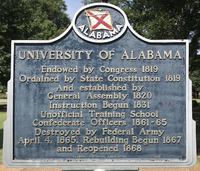 University of Alabama
University of Alabama Endowed by Congress 1819
Ordained by State Constitution 1819
And established by General Assembly 1820
Instruction begun 1831
Unofficial Training School Confederate Officers 1861-65
Destroyed by Federal Army April 5, 1865
Rebuilding began 1867
and Reopened 1868
-
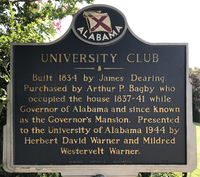 University Club
University Club Built 1834 by James Dearing. Purchased by Arthur P. Bagby who occupied the house 1837-41 while Governor of Alabama and since known as the Governor's Mansion. Presented to the University of Alabama 1944 by Herbert David Warner and Mildred Westervelt Warner.
-
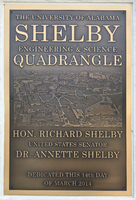 Shelby Engineering & Science Quadrangle
Shelby Engineering & Science Quadrangle [left and right]
Hon. Richard Shelby
United States Senator
Dr. Annette Shelby
Dedicated This 14th Day of March 2014
-
 Rotunda Plaza
Rotunda Plaza The Rotunda Plaza is dedicated to
John H. and Carolyn Cobb Josey
(Classes of 1950 and 1951, respectively)
In recognition of the establishment in 1992 of the John H. and Carolyn Cobb Josey Library Endowment Fund, ensuring continued excellence of library and information services to The University of Alabama.
The Flagstones embedded in this plaza mark the original foundations of the Rotunda, which housed the first library of the University of Alabama, and which, on April 4, 1865, was burned by Federal Troops. Rediscovered and excavated in 1984, the foundations symbolize the link between the Library's past and its future.
-
 The University of Alabama Moody Gallery of Art
The University of Alabama Moody Gallery of Art Dedicated in honor of Sarah McCorkle Moody
leading citizen and lifelong patron and benefactor of the arts
March 1983
-
 Military Order of the Purple Heart plaque
Military Order of the Purple Heart plaque In appreciation for your long and noble tradition of supporting and honoring the brave men and women of the military and their families, especially America's combat wounded veterans.
Special recognition as a Purple Heart University is Bestowed with Great Pride to
The University of Alabama
Presented by
The Patriot Members of Tuscaloosa Chapter 2211
Military Order of the Purple Heart
Chapter Commander, Duane A. Lamb (Colonel, USAF, Retired)
November 2013
-
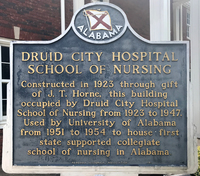 Druid City Hospital School of Nursing
Druid City Hospital School of Nursing Constructed in 1923 through gift of J. T. Horne, this building occupied by Druid City School of Nursing from 1923 to 1947. Used by University of Alabama from 1951 to 1954 to house first state supported collegiate school of nursing in Alabama.
-
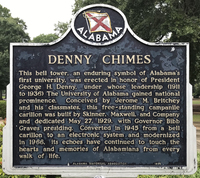 Denny Chimes
Denny Chimes [front]
This bell tower, an enduring symbol of Alabama's first university, was erected in honor of President George H. Denny, under whose leadership (1911 to 1936) The University of Alabama gained national prominence. Conceived by Jerome M. Britchey and his classmates, this free-standing campanile carillon was built by Skinner, Maxwell, and Company and dedicated May 27, 1929, with Governor Bibb Graves presiding. Converted in 1945 from a bell carillon to an electronic system and modernized in 1966, its echoes have continued to touch the hearts and memories of Alabamians from ever walk of life.
[reverse]
Exhausted by years of service, the system was replaced in 1986 with a 25-bell bronze carillon of the highest known quality and design. The funding for the bells and the establishment of a permanent fund for continuing maintenance were made possible by the University's alumni and special friends.
This marker stands as a tangible expression of gratitude to all who have participated in the erection and preservation of this historical monument.
-
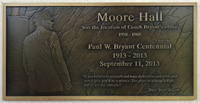 Coach Bryant office (Moore Hall) plaque [removed]
Coach Bryant office (Moore Hall) plaque [removed] Moore Hall was the location of Coach Bryant's office
1958-1968
Paul W. Bryant Centennial
1913-2013
September 11, 2013
"If you believe in yourself and have dedication and pride and never quit, you'll be a winner. The price of victory is high, but so are the rewards."
Paul 'Bear' Bryant
-
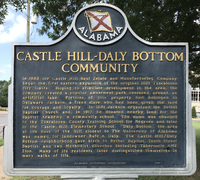 Castle Hill - Daly Bottom Community
Castle Hill - Daly Bottom Community In 1883 the Castle Hill Real Estate and Manufacturing Company began the first eastern expansion of the original 1821 Tuscaloosa city limits. Hoping to stimulate development in the area, the company created a popular amusement park centered around an artificial lake. Portions of this property had belonged to Delaware Jackson, a freed slave who had been given the land for courage and loyalty. In 1881 Jackson organized the Bethel Baptist Church and, in 1917, he donated nearby land for the Baptist Academy, a community school. The name was changed to the Tuscaloosa County Training School for Negroes and later to the Castle Hill Elementary School. “Daly Bottom,” the area at the base of the hill closest to the University of Alabama was named for landowner Rafe A. Daly. The Castle Hill/ Daly Bottom neighborhood gave birth to Bethel Baptist, Tenth Street Baptist, and two Methodist churches including Tabernacle AME Zion. Many of its residents later distinguished themselves in many walks of life.
-
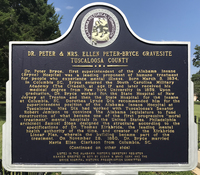 Dr. Peter & Mrs. Ellen Peter-Bryce Gravesite
Tuscaloosa County
Dr. Peter & Mrs. Ellen Peter-Bryce Gravesite
Tuscaloosa County [front]
Dr. Peter Bryce, first superintendent of the Alabama Insane (Bryce) Hospital was a leading proponent of humane treatment of people who experience mental illness. Born March 5, 1834, in Columbia SC, Bryce entered the South Carolina Military Academy (The Citadel), at age 17 and later received his medical degree from New York University in 1859. Upon graduation, Dr.Bryce worked for the State Hospital of New Jersey at Trenton and then the State Hospital for the Insane at Columbia, SC. Dorothea Lynde Dix recommended him for the superintendent position of the Alabama Insane Hospital at Tuscaloosa. Miss Dix had worked with Tuscaloosa’s Senator Robert Jemison to convince the Alabama legislature to fund construction of what became one of the first progressive “moral treatment” mental hospitals in the United States. Philadelphia architect Samuel Sloan designed the structure according to specifications of Dr. Thomas Kirkbride, the leading mental health authority of the time, and creator of the Kirkbride Linear Plan, wherein the building became part of the treatment. On November 28, 1860, Dr.Bryce married Maria Ellen Clarkson from Columbia, SC.
Continued on other side)
[reverse]
(Continued from other side)
The couple moved to Tuscaloosa where Dr. Bryce supervised the hospital, which had been under construction since 1853. In the summer of 1861, the first patient was admitted. The Bryces lived in an apartment in the hospital’s center pavilion and Mrs. Bryce joined her husband in implementing the moral treatment movement’s theories. She surrounded patients with beauty and also enhanced the landscaping of the hospital grounds. Mrs. Bryce organized pleasant activities for the patients including art and music programs. Following moral treatment philosophy, male patients worked on the hospital farm and female patients performed domestic chores. These therapeutic activities were essential during the Civil War when the hospital, with no funds from the state, relied on its own farm produce to remain open. Dr. Bryce died of Bright’s disease in 1892 and, at his request, was buried on the hospital’s front lawn. In 1929, Mrs. Bryce was buried beside him. The hospital was renamed in Dr. Bryce’s honor for his contributions to the humane treatment of people who experience mental illness.
-
 Beta Gamma Sigma
Beta Gamma Sigma The Honor Society for AACBS Accredited Business Programs
Founded 1913
The mission of Beta Gamma Sigma is to encourage and honor academic achievement and personal excellence in the study and practice of business. Membership in Beta Gamma Sigma is the highest national recognition an eligible student can receive. This key is dedicated to the memory of Dean Lee Bidgood, national president, 1950-1952.
Dedicated April 11, 1996, by the University of Alabama chapter, chartered 1931.
-
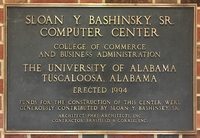 Sloan Y. Bashinsky, Sr. Computer Center
Sloan Y. Bashinsky, Sr. Computer Center Sloan Y. Bashinsky, Sr. Computer Center
College of Commerce And Business Administration
The University of Alabama
Tuscaloosa, Alabama
Erected 1994
Funds for the construction of this center were generously contributed by Sloan Y. Bashinsky, Sr.
Architect: PH&J Architects, Inc.
Contractor: Brasfield & Gorries, Inc.
 The University of Alabama School of Law [front] Founded in 1872 as the first law school in Alabama. Henderson M. Somerville was the first professor and later an Alabama Supreme Court Justice. The first dean was William L. Thorington (1897-1908). The school occupied, in turn, parts of Woods, Manly, Barnard, and Morgan Halls, and all of Farrah Hall, named for Albert J. Farrah, Law Dean, 1913 to 1944. The present Law Center, designed by Edward Durrell Stone, was completed in 1978. In the year 2000, the Law School had graduated more than 8,300 students and was ranked among the Top 50 law schools in the United States. (Continued on other side) [reverse] (Continued from other side) The University of Alabama School of Law was accredited by the American Bar Association in 1926 and has been a member of the Association of American Law Schools since 1928. At the beginning of the 21st century, the Law School offers a broad curriculum taught by a well-qualified faculty. High academic and diversity standards have assured an outstanding student body. Student academic achievement is recognized by admission to the Order of the Coif, selection to the staffs of three journals published by the Law School, participation in six moot court competitions, four national trial competitions, and numerous awards. Continuing Legal Education is offered to the licensed bar statewide from this and other locations. Service to the community and state is carried out through six law clinics. One of the Law School’s most celebrated alumni is U.S. Supreme Court Justice Hugo L. Black (Class of 1906), whose home office and personal library, donated by his family, are replicated in the school’s Bounds Law Library. Named for Donald Richard Bounds, Jr. and Russell Hampton Bounds, the library also houses the Howell T. Heflin Conference Room and the John C. Payne Special Collections Room. Graduates include numerous, state and federal judges, seven state governors, nine U.S. Senators, thirty-one U.S. Representatives, and numerous state legislators, academics, leaders of the bar, and corporate executives. Private support is provided by loyal alumni and friends through the Law Alumni Association, the Farrah Law Society, and the Law School Foundation.
The University of Alabama School of Law [front] Founded in 1872 as the first law school in Alabama. Henderson M. Somerville was the first professor and later an Alabama Supreme Court Justice. The first dean was William L. Thorington (1897-1908). The school occupied, in turn, parts of Woods, Manly, Barnard, and Morgan Halls, and all of Farrah Hall, named for Albert J. Farrah, Law Dean, 1913 to 1944. The present Law Center, designed by Edward Durrell Stone, was completed in 1978. In the year 2000, the Law School had graduated more than 8,300 students and was ranked among the Top 50 law schools in the United States. (Continued on other side) [reverse] (Continued from other side) The University of Alabama School of Law was accredited by the American Bar Association in 1926 and has been a member of the Association of American Law Schools since 1928. At the beginning of the 21st century, the Law School offers a broad curriculum taught by a well-qualified faculty. High academic and diversity standards have assured an outstanding student body. Student academic achievement is recognized by admission to the Order of the Coif, selection to the staffs of three journals published by the Law School, participation in six moot court competitions, four national trial competitions, and numerous awards. Continuing Legal Education is offered to the licensed bar statewide from this and other locations. Service to the community and state is carried out through six law clinics. One of the Law School’s most celebrated alumni is U.S. Supreme Court Justice Hugo L. Black (Class of 1906), whose home office and personal library, donated by his family, are replicated in the school’s Bounds Law Library. Named for Donald Richard Bounds, Jr. and Russell Hampton Bounds, the library also houses the Howell T. Heflin Conference Room and the John C. Payne Special Collections Room. Graduates include numerous, state and federal judges, seven state governors, nine U.S. Senators, thirty-one U.S. Representatives, and numerous state legislators, academics, leaders of the bar, and corporate executives. Private support is provided by loyal alumni and friends through the Law Alumni Association, the Farrah Law Society, and the Law School Foundation. University of Alabama Endowed by Congress 1819 Ordained by State Constitution 1819 And established by General Assembly 1820 Instruction begun 1831 Unofficial Training School Confederate Officers 1861-65 Destroyed by Federal Army April 5, 1865 Rebuilding began 1867 and Reopened 1868
University of Alabama Endowed by Congress 1819 Ordained by State Constitution 1819 And established by General Assembly 1820 Instruction begun 1831 Unofficial Training School Confederate Officers 1861-65 Destroyed by Federal Army April 5, 1865 Rebuilding began 1867 and Reopened 1868 University Club Built 1834 by James Dearing. Purchased by Arthur P. Bagby who occupied the house 1837-41 while Governor of Alabama and since known as the Governor's Mansion. Presented to the University of Alabama 1944 by Herbert David Warner and Mildred Westervelt Warner.
University Club Built 1834 by James Dearing. Purchased by Arthur P. Bagby who occupied the house 1837-41 while Governor of Alabama and since known as the Governor's Mansion. Presented to the University of Alabama 1944 by Herbert David Warner and Mildred Westervelt Warner. Shelby Engineering & Science Quadrangle [left and right] Hon. Richard Shelby United States Senator Dr. Annette Shelby Dedicated This 14th Day of March 2014
Shelby Engineering & Science Quadrangle [left and right] Hon. Richard Shelby United States Senator Dr. Annette Shelby Dedicated This 14th Day of March 2014 Rotunda Plaza The Rotunda Plaza is dedicated to John H. and Carolyn Cobb Josey (Classes of 1950 and 1951, respectively) In recognition of the establishment in 1992 of the John H. and Carolyn Cobb Josey Library Endowment Fund, ensuring continued excellence of library and information services to The University of Alabama. The Flagstones embedded in this plaza mark the original foundations of the Rotunda, which housed the first library of the University of Alabama, and which, on April 4, 1865, was burned by Federal Troops. Rediscovered and excavated in 1984, the foundations symbolize the link between the Library's past and its future.
Rotunda Plaza The Rotunda Plaza is dedicated to John H. and Carolyn Cobb Josey (Classes of 1950 and 1951, respectively) In recognition of the establishment in 1992 of the John H. and Carolyn Cobb Josey Library Endowment Fund, ensuring continued excellence of library and information services to The University of Alabama. The Flagstones embedded in this plaza mark the original foundations of the Rotunda, which housed the first library of the University of Alabama, and which, on April 4, 1865, was burned by Federal Troops. Rediscovered and excavated in 1984, the foundations symbolize the link between the Library's past and its future. The University of Alabama Moody Gallery of Art Dedicated in honor of Sarah McCorkle Moody leading citizen and lifelong patron and benefactor of the arts March 1983
The University of Alabama Moody Gallery of Art Dedicated in honor of Sarah McCorkle Moody leading citizen and lifelong patron and benefactor of the arts March 1983 Military Order of the Purple Heart plaque In appreciation for your long and noble tradition of supporting and honoring the brave men and women of the military and their families, especially America's combat wounded veterans. Special recognition as a Purple Heart University is Bestowed with Great Pride to The University of Alabama Presented by The Patriot Members of Tuscaloosa Chapter 2211 Military Order of the Purple Heart Chapter Commander, Duane A. Lamb (Colonel, USAF, Retired) November 2013
Military Order of the Purple Heart plaque In appreciation for your long and noble tradition of supporting and honoring the brave men and women of the military and their families, especially America's combat wounded veterans. Special recognition as a Purple Heart University is Bestowed with Great Pride to The University of Alabama Presented by The Patriot Members of Tuscaloosa Chapter 2211 Military Order of the Purple Heart Chapter Commander, Duane A. Lamb (Colonel, USAF, Retired) November 2013 Druid City Hospital School of Nursing Constructed in 1923 through gift of J. T. Horne, this building occupied by Druid City School of Nursing from 1923 to 1947. Used by University of Alabama from 1951 to 1954 to house first state supported collegiate school of nursing in Alabama.
Druid City Hospital School of Nursing Constructed in 1923 through gift of J. T. Horne, this building occupied by Druid City School of Nursing from 1923 to 1947. Used by University of Alabama from 1951 to 1954 to house first state supported collegiate school of nursing in Alabama. Denny Chimes [front] This bell tower, an enduring symbol of Alabama's first university, was erected in honor of President George H. Denny, under whose leadership (1911 to 1936) The University of Alabama gained national prominence. Conceived by Jerome M. Britchey and his classmates, this free-standing campanile carillon was built by Skinner, Maxwell, and Company and dedicated May 27, 1929, with Governor Bibb Graves presiding. Converted in 1945 from a bell carillon to an electronic system and modernized in 1966, its echoes have continued to touch the hearts and memories of Alabamians from ever walk of life. [reverse] Exhausted by years of service, the system was replaced in 1986 with a 25-bell bronze carillon of the highest known quality and design. The funding for the bells and the establishment of a permanent fund for continuing maintenance were made possible by the University's alumni and special friends. This marker stands as a tangible expression of gratitude to all who have participated in the erection and preservation of this historical monument.
Denny Chimes [front] This bell tower, an enduring symbol of Alabama's first university, was erected in honor of President George H. Denny, under whose leadership (1911 to 1936) The University of Alabama gained national prominence. Conceived by Jerome M. Britchey and his classmates, this free-standing campanile carillon was built by Skinner, Maxwell, and Company and dedicated May 27, 1929, with Governor Bibb Graves presiding. Converted in 1945 from a bell carillon to an electronic system and modernized in 1966, its echoes have continued to touch the hearts and memories of Alabamians from ever walk of life. [reverse] Exhausted by years of service, the system was replaced in 1986 with a 25-bell bronze carillon of the highest known quality and design. The funding for the bells and the establishment of a permanent fund for continuing maintenance were made possible by the University's alumni and special friends. This marker stands as a tangible expression of gratitude to all who have participated in the erection and preservation of this historical monument. Coach Bryant office (Moore Hall) plaque [removed] Moore Hall was the location of Coach Bryant's office 1958-1968 Paul W. Bryant Centennial 1913-2013 September 11, 2013 "If you believe in yourself and have dedication and pride and never quit, you'll be a winner. The price of victory is high, but so are the rewards." Paul 'Bear' Bryant
Coach Bryant office (Moore Hall) plaque [removed] Moore Hall was the location of Coach Bryant's office 1958-1968 Paul W. Bryant Centennial 1913-2013 September 11, 2013 "If you believe in yourself and have dedication and pride and never quit, you'll be a winner. The price of victory is high, but so are the rewards." Paul 'Bear' Bryant Castle Hill - Daly Bottom Community In 1883 the Castle Hill Real Estate and Manufacturing Company began the first eastern expansion of the original 1821 Tuscaloosa city limits. Hoping to stimulate development in the area, the company created a popular amusement park centered around an artificial lake. Portions of this property had belonged to Delaware Jackson, a freed slave who had been given the land for courage and loyalty. In 1881 Jackson organized the Bethel Baptist Church and, in 1917, he donated nearby land for the Baptist Academy, a community school. The name was changed to the Tuscaloosa County Training School for Negroes and later to the Castle Hill Elementary School. “Daly Bottom,” the area at the base of the hill closest to the University of Alabama was named for landowner Rafe A. Daly. The Castle Hill/ Daly Bottom neighborhood gave birth to Bethel Baptist, Tenth Street Baptist, and two Methodist churches including Tabernacle AME Zion. Many of its residents later distinguished themselves in many walks of life.
Castle Hill - Daly Bottom Community In 1883 the Castle Hill Real Estate and Manufacturing Company began the first eastern expansion of the original 1821 Tuscaloosa city limits. Hoping to stimulate development in the area, the company created a popular amusement park centered around an artificial lake. Portions of this property had belonged to Delaware Jackson, a freed slave who had been given the land for courage and loyalty. In 1881 Jackson organized the Bethel Baptist Church and, in 1917, he donated nearby land for the Baptist Academy, a community school. The name was changed to the Tuscaloosa County Training School for Negroes and later to the Castle Hill Elementary School. “Daly Bottom,” the area at the base of the hill closest to the University of Alabama was named for landowner Rafe A. Daly. The Castle Hill/ Daly Bottom neighborhood gave birth to Bethel Baptist, Tenth Street Baptist, and two Methodist churches including Tabernacle AME Zion. Many of its residents later distinguished themselves in many walks of life. Dr. Peter & Mrs. Ellen Peter-Bryce Gravesite
Tuscaloosa County [front] Dr. Peter Bryce, first superintendent of the Alabama Insane (Bryce) Hospital was a leading proponent of humane treatment of people who experience mental illness. Born March 5, 1834, in Columbia SC, Bryce entered the South Carolina Military Academy (The Citadel), at age 17 and later received his medical degree from New York University in 1859. Upon graduation, Dr.Bryce worked for the State Hospital of New Jersey at Trenton and then the State Hospital for the Insane at Columbia, SC. Dorothea Lynde Dix recommended him for the superintendent position of the Alabama Insane Hospital at Tuscaloosa. Miss Dix had worked with Tuscaloosa’s Senator Robert Jemison to convince the Alabama legislature to fund construction of what became one of the first progressive “moral treatment” mental hospitals in the United States. Philadelphia architect Samuel Sloan designed the structure according to specifications of Dr. Thomas Kirkbride, the leading mental health authority of the time, and creator of the Kirkbride Linear Plan, wherein the building became part of the treatment. On November 28, 1860, Dr.Bryce married Maria Ellen Clarkson from Columbia, SC. Continued on other side) [reverse] (Continued from other side) The couple moved to Tuscaloosa where Dr. Bryce supervised the hospital, which had been under construction since 1853. In the summer of 1861, the first patient was admitted. The Bryces lived in an apartment in the hospital’s center pavilion and Mrs. Bryce joined her husband in implementing the moral treatment movement’s theories. She surrounded patients with beauty and also enhanced the landscaping of the hospital grounds. Mrs. Bryce organized pleasant activities for the patients including art and music programs. Following moral treatment philosophy, male patients worked on the hospital farm and female patients performed domestic chores. These therapeutic activities were essential during the Civil War when the hospital, with no funds from the state, relied on its own farm produce to remain open. Dr. Bryce died of Bright’s disease in 1892 and, at his request, was buried on the hospital’s front lawn. In 1929, Mrs. Bryce was buried beside him. The hospital was renamed in Dr. Bryce’s honor for his contributions to the humane treatment of people who experience mental illness.
Dr. Peter & Mrs. Ellen Peter-Bryce Gravesite
Tuscaloosa County [front] Dr. Peter Bryce, first superintendent of the Alabama Insane (Bryce) Hospital was a leading proponent of humane treatment of people who experience mental illness. Born March 5, 1834, in Columbia SC, Bryce entered the South Carolina Military Academy (The Citadel), at age 17 and later received his medical degree from New York University in 1859. Upon graduation, Dr.Bryce worked for the State Hospital of New Jersey at Trenton and then the State Hospital for the Insane at Columbia, SC. Dorothea Lynde Dix recommended him for the superintendent position of the Alabama Insane Hospital at Tuscaloosa. Miss Dix had worked with Tuscaloosa’s Senator Robert Jemison to convince the Alabama legislature to fund construction of what became one of the first progressive “moral treatment” mental hospitals in the United States. Philadelphia architect Samuel Sloan designed the structure according to specifications of Dr. Thomas Kirkbride, the leading mental health authority of the time, and creator of the Kirkbride Linear Plan, wherein the building became part of the treatment. On November 28, 1860, Dr.Bryce married Maria Ellen Clarkson from Columbia, SC. Continued on other side) [reverse] (Continued from other side) The couple moved to Tuscaloosa where Dr. Bryce supervised the hospital, which had been under construction since 1853. In the summer of 1861, the first patient was admitted. The Bryces lived in an apartment in the hospital’s center pavilion and Mrs. Bryce joined her husband in implementing the moral treatment movement’s theories. She surrounded patients with beauty and also enhanced the landscaping of the hospital grounds. Mrs. Bryce organized pleasant activities for the patients including art and music programs. Following moral treatment philosophy, male patients worked on the hospital farm and female patients performed domestic chores. These therapeutic activities were essential during the Civil War when the hospital, with no funds from the state, relied on its own farm produce to remain open. Dr. Bryce died of Bright’s disease in 1892 and, at his request, was buried on the hospital’s front lawn. In 1929, Mrs. Bryce was buried beside him. The hospital was renamed in Dr. Bryce’s honor for his contributions to the humane treatment of people who experience mental illness. Beta Gamma Sigma The Honor Society for AACBS Accredited Business Programs Founded 1913 The mission of Beta Gamma Sigma is to encourage and honor academic achievement and personal excellence in the study and practice of business. Membership in Beta Gamma Sigma is the highest national recognition an eligible student can receive. This key is dedicated to the memory of Dean Lee Bidgood, national president, 1950-1952. Dedicated April 11, 1996, by the University of Alabama chapter, chartered 1931.
Beta Gamma Sigma The Honor Society for AACBS Accredited Business Programs Founded 1913 The mission of Beta Gamma Sigma is to encourage and honor academic achievement and personal excellence in the study and practice of business. Membership in Beta Gamma Sigma is the highest national recognition an eligible student can receive. This key is dedicated to the memory of Dean Lee Bidgood, national president, 1950-1952. Dedicated April 11, 1996, by the University of Alabama chapter, chartered 1931. Sloan Y. Bashinsky, Sr. Computer Center Sloan Y. Bashinsky, Sr. Computer Center College of Commerce And Business Administration The University of Alabama Tuscaloosa, Alabama Erected 1994 Funds for the construction of this center were generously contributed by Sloan Y. Bashinsky, Sr. Architect: PH&J Architects, Inc. Contractor: Brasfield & Gorries, Inc.
Sloan Y. Bashinsky, Sr. Computer Center Sloan Y. Bashinsky, Sr. Computer Center College of Commerce And Business Administration The University of Alabama Tuscaloosa, Alabama Erected 1994 Funds for the construction of this center were generously contributed by Sloan Y. Bashinsky, Sr. Architect: PH&J Architects, Inc. Contractor: Brasfield & Gorries, Inc.